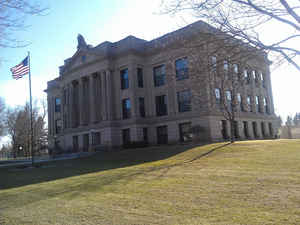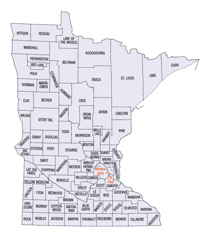Minnesota Counties
There are eighty-seven Counties in Minnesota. On October 27, 1849 nine large Minnesota Counties were created. Among them were Benton, Dahkotah, Itasca, Ramsey, Mahkahta, Pembina, Wabashaw, Washington, and Wahnata. Of those Benton, Dakota, Itasca, Ramsey, Wabasha, and Washington still exist as their original name. With the creation of Kittson County on March 9, 1878, Pembina County no longer existed. When Minnesota was organized as a state, 57 of the present 87 Counties were established. The last county to be created was Lake of the Woods County in 1923Lincoln County, Minnesota
Lincoln County Education, Geography, and History
Lincoln County is a county located in the state of Minnesota. Based on the 2010 census, the population was 5,896. Its county seat is Ivanhoe
Etymology - Origin of Lincoln County Name
Named for Abraham Lincoln, member of Congress from Illinois, 1847-49; president of the United States, 1861-65.
Demographics:
County QuickFacts: CensusBureau Quick Facts
Lincoln County History
Lincoln County was created in 1873 from the western portion of Lyon County. After numerous changes, its county seat has been Ivanhoe since 1904.
Early European Settlement
Two early explorers, Joseph H. Nicollet and John C. Fremont, headed a group of scientists who crossed what would someday become Lincoln
County in 1838. They were part of a government exploration of the region lying between the Mississippi and the Missouri Rivers. They are the
first explorers to leave an official record of an examination of the interior of our continent.
The Sisseton and Wahpeton bands of the Sioux Indians were ranging in southwestern Minnesota in the early years of the 19th century. It is not
known how long they had been here. The area remained in possession of these Native Americans until the title to a vast tract in Minnesota,
Iowa, and South Dakota (including the future Lincoln County) was relinquished by the Sioux to the United States government under terms of the
1851 treaties of Traverse De Sioux and Mendota.
A few people settled near Lake Benton before the summer of 1862. Later settlers in the latter 1860's discovered six partially burned houses
scattered around that lake. Several tracts of land had been broken, a considerable number of logs and posts had been cut, and a quantity of
rails split. Nothing is known as to who these settlers were or what their fate had been. They may have perished in a battle with Indians, or
they may have joined in the exodus which depopulated the southwestern part of the State for several years.
Pioneer homes were built in scattered parts of the county in the late 1860's and early 1870's. Permanent settlers arrived in the present
township of Lake Benton in 1868. Only a few came in the next fifteen years and in the spring of 1875 there were only 413 white settlers in the
county.
The intensely cold winters and blizzards, summer hail and drought, insect pests, crop failures, and poverty all combined to create a feeling
of discouragement. Many early settlers left in despair. Others, better suited for the difficult pioneer life by temperament, physical stamina,
and social organization were soon to come in and establish their communities on a firmer basis.
The Icelandic, Danish, and Norwegian colonies were of such substantial foundation that their descendants still constitute a considerable
element in the present population. The Icelandic group centers around Ivanhoe, the first of whom settled in 1878. By 1925 there were about
1,000 first- and second-generation Icelanders in the county.
Creating "Lincoln County"
Lincoln County, named after Abraham Lincoln, was created by the Minnesota Legislature on March 6, 1873. But what we know today as Lincoln
County was not Minnesota's first attempt to honor the assassinated president.
A patriotic Minnesota Legislature, desiring to honor Lincoln upon his assumption of the presidency in 1861, sought to give his name to a
county established from the northeastern part of the present Renville County, with the addition of the two southernmost townships now in
Meeker County. But this act failed to receive the necessary ratification by the people of the affected counties.
A second attempt to honor Lincoln came in March of 1866, when the State Legislature sought to change the name of Rock County to "Lincoln"
County. This act was ignored by the people of Rock County.
A third unsuccessful attempt came on February 12, 1870, on the anniversary of Lincoln's birth. Another effort was made to remove part of
eastern Renville County and establish "Lincoln" County, but not with the same borders as had been proposed in 1861. Once again, this failed to
be ratified by the local people.
Finally, in 1873, Lincoln County was successfully created out of the western part of Lyon County, with the support of the voters. Counties
have been named for Abraham Lincoln in fifteen other states.
The Battle for the County Seat
Every county needs a county seat, a city which serves as the seat of government for the county. That fortunate community becomes the focal
point of the county and is where the Courthouse is located. In the early days, being the county seat held out the potential for healthy growth
and economic development; it is no wonder, then, that the location of the county seat can grow into a major controversy, as was the case in
Lincoln County.
The first county seat was at "Marshfield," a community platted in 1873. However, when the cities of Tyler and Lake Benton began to develop due
to the presence of railroad lines, several buildings were moved from Marshfield to each of those other cities. By the close of the winter of
1880-81, business had almost ceased at the Marshfield county seat. Today only a few abandoned buildings remain of "Marshfield."
Seeing the demise of Marshfield, the people of Lake Benton petitioned for the removal of the county seat to their village. At a county-wide
election in 1881, a majority of nine votes favored relocating the county seat to Lake Benton. This narrow victory was immediately (but
unsuccessfully) contested in the District Court. With the legal challenge having been dismissed in 1883, the county seat was (for a time, at
least) firmly established at Lake Benton.
The establishment of the city of Ivanhoe in 1900 brought another player into the contest for the county seat. Acting upon petitions, the
County Commissioners ordered a special election in 1901, calling for the county seat to be moved to Ivanhoe. The measure was passed, but the
validity of the election was challenged. A legal appeal which eventually led up to the State Supreme Court found that the election was void
because the County Auditor had failed to properly post notices of the Commissioner's hearing on the proposition to call the special election.
On August 5, 1904, yet another election was held on the petition to move the county seat. Out of the 2,274 votes case, 1,310 were in favor of
moving the county seat to Ivanhoe, where it has remained ever since.
Building a Courthouse
Lincoln County began its history without a "home," that is, without a formal courthouse building to house the local government.
The first meeting of the County Commissioners was held at the home of M. S. Phillips in Marshfield. Later meeting were held in a store
building. The County officials had their offices in various homes and stores in Marshfield until 1881, when they moved their official
headquarters to Lake Benton. The railroad company had donated a courthouse site and the citizens of Lake Benton provided a courthouse
building, which was later enlarged and improved.
Then began the "Battle for the County Seat."
In 1901, after the voters had approved moving the county seat to Ivanhoe, the county accepted a donation of a courthouse site from
landowners in that community. The legal challenges to the location of the county seat delayed construction of a courthouse building until
1903, when a contract was let for building a combined jail and sheriff's residence in Ivanhoe, to be financed by an appropriation of $17,000
from accumulated tax levies.
However, later that year the Minnesota Supreme Court declared that Lake Benton, not Ivanhoe, was the county seat. Switching gears, the county
decided that the old courthouse in Lake Benton should be repaired. The election of 1904 finally located the county seat in Ivanhoe and, with
that decision made, plans moved forward for final construction of a new courthouse.
A contract for construction of the facility in Ivanhoe was let in 1919 at a cost of $143,200. Subsequent contracts were awarded for heating ,
ventilating, plumbing, electric lighting, interior marble finishing, furniture, and interior oil murals. The three-story courthouse which
stands today is a structure of 108 feet x 75 feet, built of Bedford granite. Construction was completed in 1920.
Geography: Land and Water
As reported by the Census Bureau, the county has a total area of 548 square miles (1,420 km2), of which 537 square miles (1,390 km2) is land and 12 square miles (31 km2) (2.1%) is water.
Neighboring Counties
Bordering counties are as follows:
- Yellow Medicine County (north)
- Lyon County (east)
- Pipestone County (south)
- Brookings County, South Dakota (west)
- Deuel County, South Dakota (northwest)
Education







